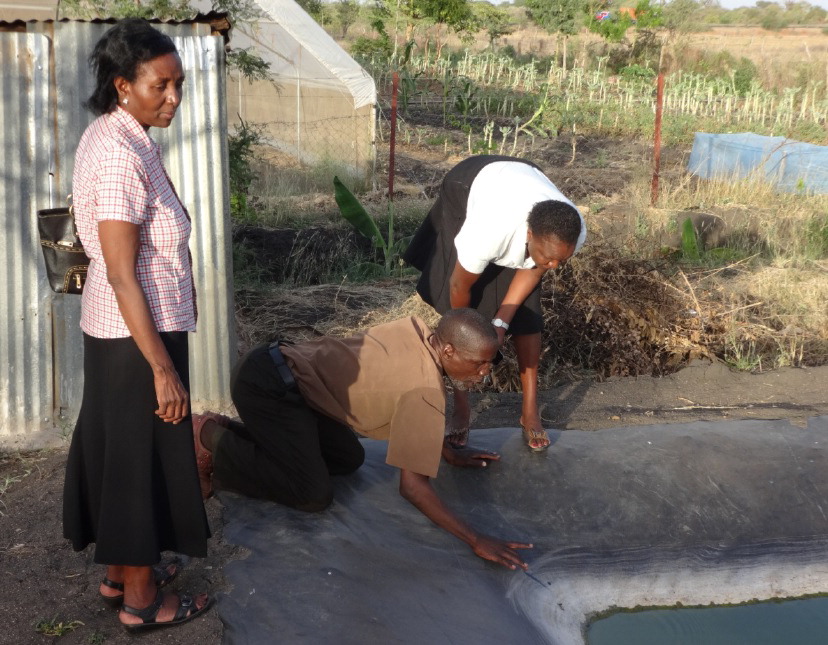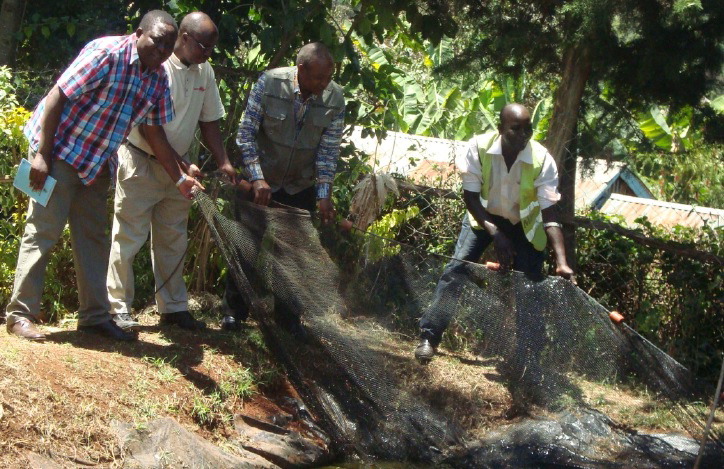This PEER project covered various aspects of the farmed fish value chain during the three years, resulting in interesting findings and ongoing discussions with stakeholders.
The study on profitability of fish farming showed that farmed fish had very short value chains and because of this, fish farmers were also engaged in other enterprises. Fish farmers with three or more ponds consistently made profits with catfish being the most profitable cultured fish and black clay soil sites the best for fish farming. The study recommended that the county promote large scale fish farming at sites with the most potential and fish farming be integrated with other enterprises.
The presence of ecto and endo parasites in farmed fish in Nyeri and the prevalence among different species and production methods was communicated to stakeholders. A group was formed consisting of the University of Nairobi and other stakeholders in Nyeri to continue this discussion and discuss ways of increasing fish productivity to feed into the new Wamagana Fish processing factory in Nyeri. Their evaluation of feed resources in Nyeri led to Othaya feed millers improving fish feeds that are supplied farmers. In their analyses, they found that some of the raw materials they were using were of low nutritional quality, resulting in fish feed with low protein content. After working with the millers to improve their feeds, the last sample they sent to the PI’s lab had doubled the protein levels. The farmers used their data to improve the way they made their feeds and it is in the process of certification by the Kenya Bureau of Standards.
Using molecular techniques, Dr. Maina reports there is very little variation among brood stock in some of the hatcheries that supply fingerlings to farmers, as well as little variation among catfish in Lake Naivasha. The team has planned presentations at the Aquaculture Round Table where they will discuss this with policy makers. Their studies showed that the catfish found in that lake may have all come from one pair, which was communicated to stakeholders, but have since been requested to conduct additional studies and increase the number of sampling sites.

Dr. Maina and Paul Wesonga (PhD student) assessing water levels in a fish pond (Photo courtesy Dr. Maina)
|
In Kibwezi, the PI and her team conducted a study on the profitability of fish farming when compared to other enterprises in the region. The student who did that work presented his findings and recommendations to the Cabinet Secretary for Agriculture, Livestock and Fisheries and also to the Principal Secretary in charge of State Department of Fisheries and the Blue Economy. He has been nominated as a board member for the State Department of Fisheries and Blue Economy. In addition, he has received grant from another project to train farmers in 7 Counties in Kenya.
In Migori, they found extremely high levels of mercury in fish and sediments collected in gold mining and adjacent areas. The team aims to continue with this work and determine the extent of environmental contamination with mercury and the effects on vulnerable populations.
Through this PEER project; capacity was built among researchers including graduate students and their supervisors on participatory research. This capacity has also been built among researchers at the Kenya marine and Fisheries Research Institute and the Kenya Agriculture and Livestock Research Institution. More researchers are now using participatory methods in their research. The team supported two PhD and four Masters students.
PublicationsMaina, J. G. Wesonga, P. S; Mukoya-Wangia, S; Njoka, J. T. (2017). Status of Fish Farming in Makueni County, Kenya - Universal Journal of Agricultural Research, 5, 61 - 68.
Maina, J.G., Gichure, J.N and Karuri, E.G ( 2015). Farmed fish value chain analysis with emphasis on value addition and traceability: case of Kirinyaga County in Kenya. Practical Action Publishing Vol. 5, Issue 3 (2015)
Wesonga, P. S.; Mukoya-Wangia, S. Maina, J. G; Njoka, J. T.(2016). Profitability of Economic Stimulus Program (ESP) fish farming adopters in Makueni County, Kenya. International Journal of Fisheries and Aquaculture Research, Vol.2 No.3 pp1-12 December, 2016
Wesonga, P. S.; Mukoya-Wangia, S. Maina, J. G; Njoka, J. T; Serykhan. (2017) Enabling environment for fish farming as an alternative livelihood in Makueni County, Kenya. International Journal of Fisheries and Aquatic Studies, Vol. 5 issue 2
S K Mavuti, R M Waruiru, P G Mbuthia, J G Maina, J M Mbaria and R O Otieno (2017). Prevalence of ecto and endo-parasitic infections of farmed tilapia and catfish in Nyeri County, Kenya. Livestock Research for Rural Development 29 (6) 2017.
SK Mavuti, RM Waruiru, PG Mbuthia, JG Maina and JM Mbaria (2017). Evaluation of fish farmer management practices in Nyeri County, Kenya. International Journal of Fisheries and Aquatic Studies. Volume 5 Issue 3 Part C (2017).
Back to PEER Cycle 2 Grant Recipients




